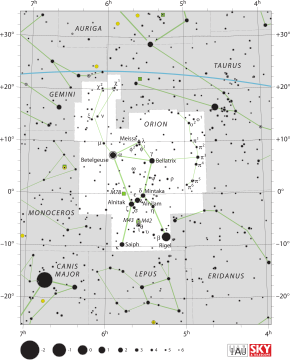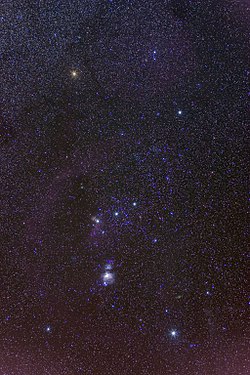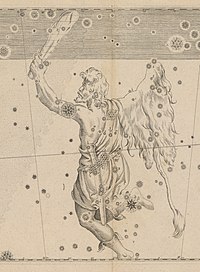Orion (constellation): Difference between revisions
m Reverted edits by 74.118.78.121 to last version by B.d.mills |
No edit summary |
||
| Line 32: | Line 32: | ||
Orion is standing next to the river [[Eridanus (constellation)|Eridanus]] with his two hunting dogs [[Canis Major]] and [[Canis Minor]], fighting [[Taurus (constellation)|Taurus]] the bull. Other prey of his, such as [[Lepus (constellation)|Lepus]] the [[hare]], can be found nearby. |
Orion is standing next to the river [[Eridanus (constellation)|Eridanus]] with his two hunting dogs [[Canis Major]] and [[Canis Minor]], fighting [[Taurus (constellation)|Taurus]] the bull. Other prey of his, such as [[Lepus (constellation)|Lepus]] the [[hare]], can be found nearby. |
||
In [[Australia]], the belt and sword of Orion are sometimes called the [[Saucepan]], because the stars of Orion's belt and sword resemble this kitchen utensil as seen from the southern hemisphere. Orion's Belt is called "The Three Kings" (or "The Magi") in some places{{fact}}. |
In [[Australia]], the belt and sword of Orion are sometimes called the [[Saucepan]], because the stars of Orion's belt and sword resemble this kitchen utensil as seen from the southern hemisphere. Orion's Belt is called "The Three Kings" (or "The Magi") in some places{{fact}}. The constellation is also known as an "Amber" in other commonwealth countries such as the United Kingdom. |
||
==Notable features== |
==Notable features== |
||
Revision as of 23:10, 5 December 2006
| Constellation | |
 | |
| Abbreviation | Ori |
|---|---|
| Genitive | Orionis |
| Right ascension | 5 |
| Declination | 5 |
| Area | 594 sq. deg. (26th) |
| Stars brighter than 3.00m | 8 |
| Stars within 10.00 pc (32.62 ly) | 2 |
| Brightest star | Rigel (β Orionis) (0.12m) |
| Meteor showers | |
| Bordering constellations | |
| Visible at latitudes between +85° and −75°. Best visible at 21:00 (9 p.m.) during the month of January.  | |
Orion (IPA: /ə(ʊ)ˈrʌɪən/), a constellation often referred to as The Hunter, is a prominent constellation, perhaps the best-known and most conspicuous in the sky. Its brilliant stars are found on the celestial equator and are visible throughout the world, making this constellation universally recognized. In the northern hemisphere Orion is visible in the evening from November to April.
Orion is standing next to the river Eridanus with his two hunting dogs Canis Major and Canis Minor, fighting Taurus the bull. Other prey of his, such as Lepus the hare, can be found nearby.
In Australia, the belt and sword of Orion are sometimes called the Saucepan, because the stars of Orion's belt and sword resemble this kitchen utensil as seen from the southern hemisphere. Orion's Belt is called "The Three Kings" (or "The Magi") in some places[citation needed]. The constellation is also known as an "Amber" in other commonwealth countries such as the United Kingdom.
Notable features
The constellation is extremely rich in bright stars and in deep-sky objects. Here are some of its stars:
- λ Ori (Meissa) is Orion's head.
- α Ori (Betelgeuse), at its right shoulder, is a red star with a diameter larger than the orbit of Venus. Although it is the α-star, it is somewhat fainter than Rigel. Betelgeuse is actually a sextuple star (other studies say it has only two companions, and the existence of any companion at all is disputed), but its companions are too small to be easily seen. It forms a point of the Winter Triangle.
- γ Ori (Bellatrix), "warrior woman", is at Orion's left shoulder.
- ζ Ori (Alnitak), ε Ori (Alnilam) and δ Ori (Mintaka) make up the asterism known as Orion's Belt: three bright stars in a row; even from these alone one can recognize Orion.
- η Ori (Eta Orionis), between Delta Orionis and Rigel.
- κ Ori (Saiph) is at Orion's right knee.
- β Ori (Rigel), at the constellation's left knee, is a large blue-white star, among the brightest in the sky. It has three companions, also difficult to see.
- ι Ori (Hatsya) is at the tip of Orion's sword.

The major stars of Orion are all very similar in age and physical characteristics, suggesting that they may have a common origin. Betelgeuse is the single exception to this.
Orion is very useful in locating other stars. By extending the line of the Belt southeastward, Sirius (α CMa) can be found; northwestward, Aldebaran (α Tau). A line eastward across the two shoulders indicates the direction of Procyon (α CMi). A line from Rigel through Betelgeuse points to Castor and Pollux (α Gem and β Gem). Additionally, Betelgeuse forms part of the Winter Triangle, and Rigel is part of the Winter Circle. Sirius and Procyon, which may be located from Orion by tracing lines, also are points in both the Triangle and the Circle.
Notable deep sky objects
Hanging from Orion's belt is his sword, consisting of the multiple stars θ1 and θ2 Orionis, called Trapezium and the nearby Orion Nebula (M42). This is a spectacular object which can be clearly identified with the naked eye as something other than a star; using a pair of binoculars, its swirling clouds of nascent stars, luminous gas, and dust can be observed.
Another famous nebula is IC 434, the Horsehead Nebula, near ζ Orionis. It contains a dark dust cloud whose shape gives the nebula its name.
Besides these nebulae, surveying Orion with a small telescope will reveal a wealth of interesting deep sky objects, including Barnard's Loop, M43, M78 and the Flame Nebula (NGC 2024).
All of these nebulae are part of the larger Orion Molecular Cloud Complex which is located approximately 1,500 light years away and is hundreds of light years across. It is one of the most intense regions of stellar formation visible in our galaxy.
History
The configurations of the constellation Orion roughly formed about 1.5 million years ago, because of relative slow movements of stars within the constellation from earth's perspective (especially the belt of Orion), constellation Orion will remain visible in the night sky for the next 1 to 2 million years, making the constellation one of the longest observable constellation parallel to the rise of human civilization. (result generated from SkyChart III).
Being so bright and distinctive, the pattern of stars that form Orion were recognized as a coherent constellation by many ancient civilizations, though with different representations and mythologies.
The ancient Sumerians saw this star pattern as a sheep, while in ancient China, Orion was one of the 28 zodiac signs Xiu (宿). Known as Shen (參), literally meaning "three", it is believed to be named so for the three stars located in Orion's belt. (See Chinese constellation)
The stars were associated with Osiris, the god of death and underworld, by the ancient Egyptians. The Giza pyramid complex, which consists of the Great Pyramid of Giza, the Pyramid of Khafre and the Pyramid of Menkaure, is said to be a sky-map of the Belt of Orion, that is, of Osiris.
The "belt and sword" of Orion are frequently referred to in ancient and modern literature, and even found recognition as the shoulder insignia of the 27th Infantry Division of the United States Army during both World Wars, probably because the division's first commander was Major General John F. O'Ryan.
Mythology

It is not very surprising to see such a prominent constellation to have more than one version of a story surrounding it in Greek mythology.
In one version, Artemis, the goddess of hunt and the moon fell in love with him and stopped doing her job of illuminating the sky at night. Her twin brother Apollo, seeing Orion swimming on the sea, dared his sister to strike what only appeared to be a spot on the waves. Not knowing it was Orion, Artemis shot an arrow and killed him. Later, when she found out what she did, she placed his body among the stars. The grief she felt explains why the moon looks so sad at night.
In a different ending of this myth, Apollo's jealousy led him to summon a giant scorpion, which not even the mighty hunter Orion could defeat, and he was killed by its poisonous sting. This explains the seasonal alternation of the appearance of the constellations of Orion (October to April) and Scorpius (April to October), which do not appear in the sky together.
It may be that the naming of the constellation precedes the mythology in this case. It has been suggested that Orion is named from the Akkadian Uru-anna, the light of heaven, the name then passing into Greek mythology. As such, the myth surrounding Orion may derive simply from the relative positions of the constellations around it in the sky.
In some depictions, Orion appears to be composed of three bodies, having three arms [1], two divergent legs, and a small central one, as well as the three bodies being bound at the waist. As such, together with other features of the area in the Zodiac sign of Gemini (i.e. the Milky Way, the deserted area now considered as the constellations Camelopardalis and Lynx, and the constellations Gemini, Auriga, and Canis Major), this may be the origin of the myth of the cattle of Geryon, which forms one of The Twelve Labours of Herakles.
In Finnish mythology the constellation of Orion is called the scythe of Väinämöinen. The term most likely comes from the fact it can be seen in the sky in early autumn in the Northern Hemisphere, the time of haymaking.
In ancient Aram, the constellation was known as Nephila, Orion's descendants were known as Nephilim[1].
In literature

The constellation is mentioned in Horace's Odes, Homer's Odyssey and Iliad, and Virgil's Aeneid.
The constellation of Orion also appears in Milton's Paradise Lost, and Tennyson's Locksley Hall, "Great Orion sloping slowly to the west".
The Bible mentions Orion 3 times: Job 9:9, Job 38:31 , and Amos 5:8.
In the Middle-earth mythos of J. R. R. Tolkien, Menelmacar is the Quenya elven name for Orion.
Adrienne Rich wrote the poem, "Orion", in which she describes how she viewed him differently from childhood to middle age. The Romanian poet Geo Bogza devoted a poem to Orion. The opening lines of the poem "The Star-Splitter" by Robert Frost accurately describe the rising of Orion: "You know Orion always comes up sideways. / Throwing a leg up over our fence of mountains".
In popular culture
- Orion is a protector in Jimmy Buffett's book The Jolly Mon.
- Orion was the star constellation that was first recognized symbol, initially mistaken as a character from an ancient or alien language, on the star gate device in the film Stargate.
- Orion was the name given to the Aurora-class cruiser that the Atlantis crew commandeered late in the second season of Stargate:Atlantis.
- Orion was the name of the cat in the movie Men in Black, when the term 'Orion's Belt' was repeatedly mistaken for the constellation; the belt referred to the cats collar.
- In the Star Trek fictional universe, Orion is home to a civilization of green-skin humanoids that practice a slave trade using their women. The Orion Syndicate is an interplanetary organized crime ring within this society.
- In the movie Blade Runner, the Replicant portrayed by Rutger Hauer tells Harrison Ford's character that he has "seen things you people wouldn't believe, attack ships on fire off the shoulder of Orion."
- "Orion" is the ultimate goal in the "Master of Orion" series for DOS and PC
- "Orion the Hunter" is a comic book produced by Blue Water Productions.
- "Orion" is the name chosen by NASA for the Crew Exploration Vehicle (CEV), as officially announced on August 22, 2006, to be built by Lockheed Martin, as announced on August 31, 2006. A NASA spacecraft program from the 1960's was named "Gemini" after the constellation adjacent to Orion that is associated with The Twins (with that spacecraft having a two-person crew).
- Architect Daniel Libeskind used the Orion constellation in his concept for the design of the London Metropolitan University Graduate Centre.
In music
- "Orion" is the title of a instrumental piece by the heavy metal band Metallica, which appeared on their 1986 album Master of Puppets.
- The Sword of Orion is the name of a composition of music by composer Vangelis on his 1976 album, Albedo 0.39.
- "Orion" is the name of a song by Jethro Tull, on the album Stormwatch.
- "The Arms of Orion" is the name of the song from the Batman Soundtrack (1989) performed by Prince and Sheena Easton. Additionally, it is a band from West Chester, Pennsylvania.
- The song "Untouchable Face" by Ani DiFranco, describes the alignment of billiard balls by saying "I see Orion and say nothing".
- Bruce Springsteen mentions Orion in Devils & Dust (2005).
- Beaver's song "Morocco" from their split EP with Queens of the Stone Age contains the line "Onto the buckle of Orion's belt".
- "Orion - The Hunter" is a composition by symphonic metal masters Symphony X, off the album "Twilight In Olympus"
- "The Pharaoh Sails To Orion", a song by Finnish opera metal band Nightwish, from their second album Oceanborn
- The song "I Can Tell" by post-hardcore band Saosin references the constellation in the line "Orion glows / And his eyes open up."
- Orion is the title of an Anais Mitchell song on Hymns for the Exiled (2004).
Stars
Stars with proper names
- (58/α Ori) 0.45 – variable Betelgeuse [Betelgeuze, Beteiguex] or Mankib [Al Mankib]
- < misreading of يد الجوزاء yad al-jauzā´ Hand of the central one [For a history of the error, see the article.]
- < منكب mankib shoulder
- (19/β Ori) 0.18 Rigel or Algebar [Elgebar]
- < رِجل الجبار rijl[u] al-jabbār Leg of the mighty [one]
- (24/γ Ori) 1.64 Bellatrix
- < bellātrix The (female) warrior/amazon
- (34/δ Ori) – double 2.25 & 6.85 Mintaka [Mentaka, Mintika]
- < منطقة minţaqa[h] Belt (west end)
- (46/ε Ori) 1.69 Alnilam [Alnihan, Alnitam]
- < النظام an-niz̧ām The arrangement [of pearls]
- (50/ζ Ori) – double 1.74, 4.21 Alnitak [Alnitah]
- < النطاق an-niţāq: The belt (east end)
- < trapezium < τραπέζιον
- (28/η Ori) 3.35 Saif al Jabbar or Algiebba
- < سيف الجبار saif al-jabbār Sword of the mighty [one]
- (44/ι Ori) 2.75 Hatsya or Na'ir al Saif
- Na'ir al Saif < نير السيف nair[u] as-saif Tip of the sword
- (53/κ Ori) 2.07 Saiph
- < سيف saif sword
- (39/λ Ori) – double 3.39, 5.61 Meissa or Heka
- < ? al-maisan The shining one
- < ? al-haq'ah The white spot
- (1/π3 Ori) 3.19 Tabit or Hassaleh – nearby
- < الثابت aθ-θābit The endurer (fixed/constant one)
- < الثابت aθ-θābit The endurer (fixed/constant one)
Stars with Bayer designations
You must add a |reason= parameter to this Cleanup template – replace it with {{Cleanup|section|reason=<Fill reason here>}}, or remove the Cleanup template.
- 43/θ2 Ori 4.98; 61/μ Ori 4.12; 67/ν Ori 4.42; 70/ξ Ori 4.45; 4/ο1 Ori 4.71; 9/ο2 Ori 4.06; 7/π1 Ori 4.64; 2/π2 Ori 4.35; 3/π4 Ori 3.68; 8/π5 Ori 3.71; 10/π6 Ori 4.47; 17/ρ1 Ori 4.46; 48/σ Ori – double 3.77, 6.65; 20/τ Ori 3.59; 54/χ1 Ori 4.39 – nearby; 62/χ2 Ori 4.64; 37/φ1 Ori 4.39; 40/φ2 Ori 4.09; 30/ψ Ori 4.59; 47/ω Ori 4.50; 51/b Ori 4.90; 42/c Ori 4.58; 49/d Ori 4.77; 29/e Ori 4.13; 69/f1 Ori 4.95; 72/f2 Ori 5.34; 6/g Ori 5.18; 16/h Ori 5.43; 14/i Ori 5.33; 74/k Ori 5.04; 75/l Ori 5.39; 23/m Ori – double 4.99, 7.12; 33/n1 Ori 5.46; 38/n2 Ori 5.32; 22/o Ori 4.72; 27/p Ori 5.07; 32/A Ori 4.20
Stars with Flamsteed designations
You must add a |reason= parameter to this Cleanup template – replace it with {{Cleanup|section|reason=<Fill reason here>}}, or remove the Cleanup template.
- 5 Ori 5.33; 11 Ori 4.65; 13 Ori 6.15; 15 Ori 4.81; 21 Ori 5.34; 25 Ori 4.89; 31 Ori 4.71; 35 Ori 5.60; 45 Ori 5.24; 52 Ori 5.26; 55 Ori 5.36; 56 Ori 4.76; 57 Ori 5.92; 59 Ori 5.89; 60 Ori 5.21; 63 Ori 5.67; 64 Ori 5.14; 66 Ori 5.63; 68 Ori 5.76; 71 Ori 5.20; 73 Ori 5.44; 77 Ori 5.19; 78 Ori 5.55
See also
Citations
- ^ Peake's commentary on the Bible
